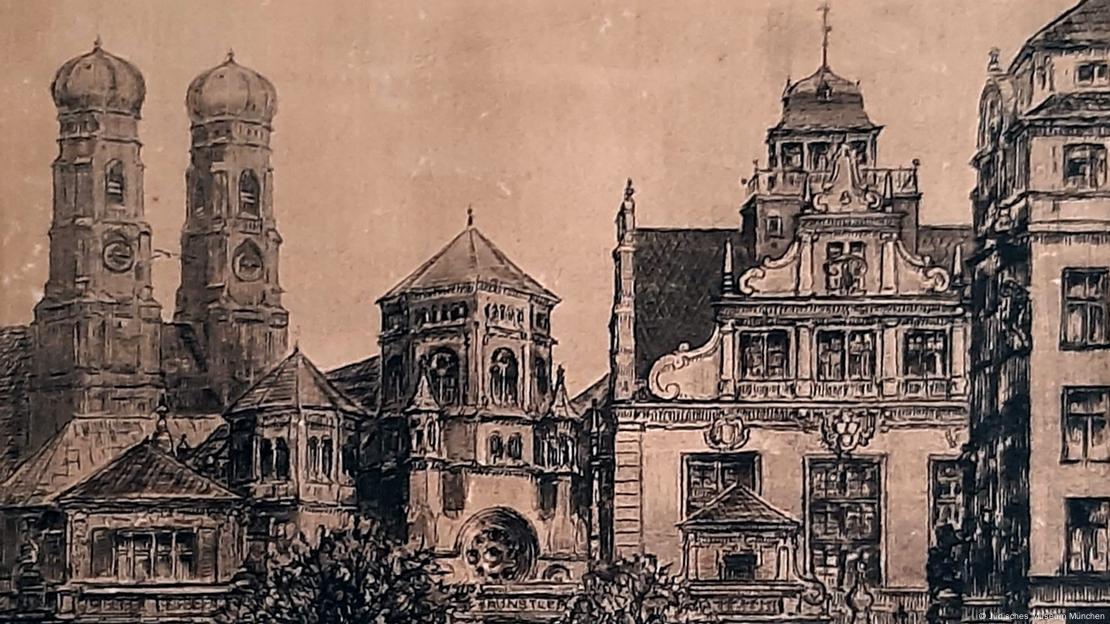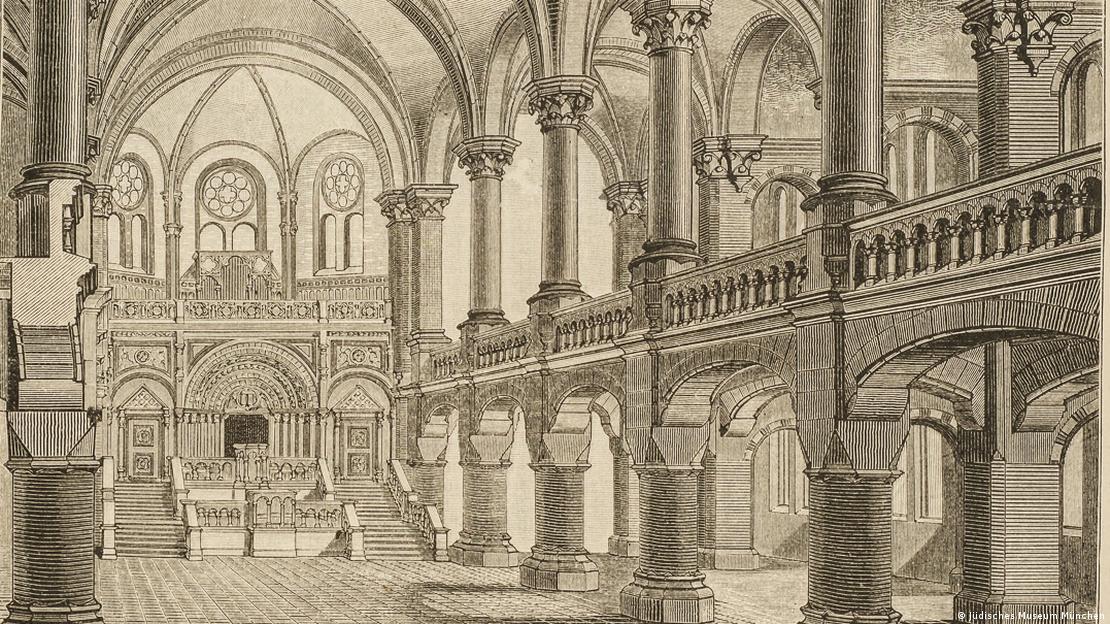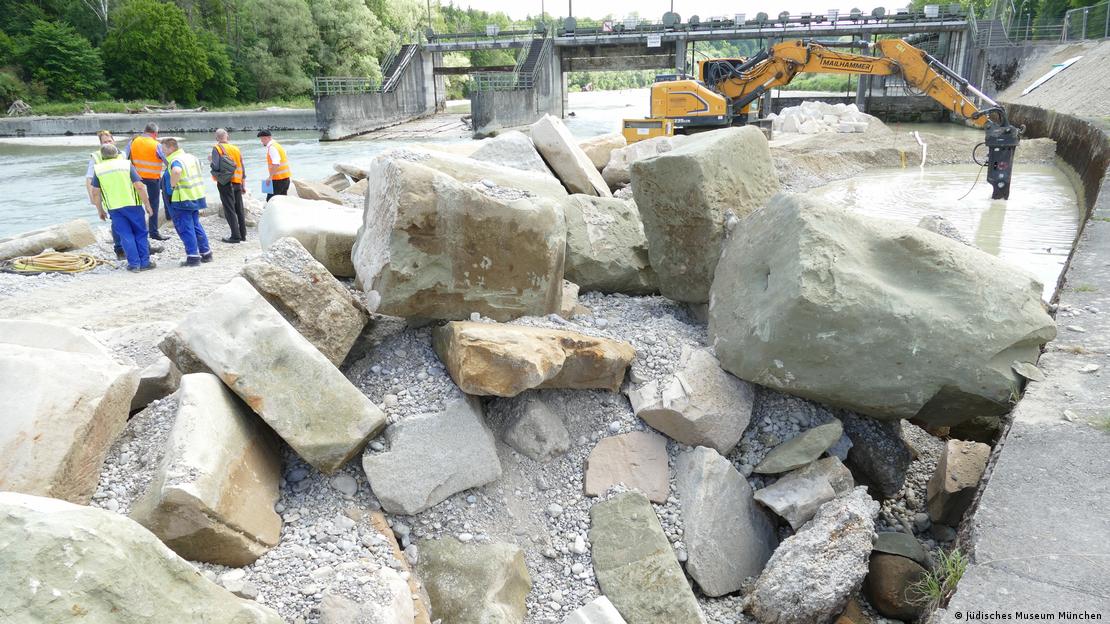The remains of Munich's Great Synagogue, the first in Germany to be destroyed under Hitler's orders, were found in the Isar River.
Stefan Dege
DW
One of the stones found in the Munich river

Unexpected find in Munich's Isar river
The remains of the synagogue have now resurfaced 85 years after its destruction.
While working on the renovation of a weir on the Isar River, construction workers found fragments of the building. Among the 150 tons of stone found in the middle of the river at a depth of two to eight meters (6.5 to 26 feet) were pieces of masonry featuring artistic friezes and a carving of a tablet with the Ten Commandments in Hebrew.


A test run for the November pogroms
Munich's main synagogue was already destroyed in June 1938, months before the Kristallnacht pogrom led by Nazi forces in November 1938, during which Jewish places of worship were burned all over Germany, and Jews were persecuted, mistreated, arrested and killed.
The previously destroyed synagogue in Munich was also a way to test the general population's lack of reaction in support of the Jews, says Purin.
Where the rubble first landed
The Munich construction company Leonhard Moll received the contract for the demolition, and initially stored the rubble from the synagogue on its building yard site, until it was commissioned to repair the Isar dam in 1956, when the synagogue's remains were apparently dumped into the river by the ton.

Image: Jüdisches Museum München
Until Adolf Hitler personally ordered its destruction, the Great Synagogue was an integral part of Munich's cityscape.
Historical documents show Munich's main synagogue being inaugurated in 1887 on Herzog-Max-Strasse, today's Lenbachplatz. As the third-largest Jewish house of worship in Germany back then, it had stood right next to the city's Catholic cathedral, fitting perfectly into Munich's old town.
It was "a symbol of long and hard-fought Jewish equality," as described by the Jewish Museum Munich in a blog post.
This was probably why it was a thorn in the flesh for the Nazis. On Hitler's orders, the synagogue was destroyed on June 9, 1938.
Until Adolf Hitler personally ordered its destruction, the Great Synagogue was an integral part of Munich's cityscape.
Historical documents show Munich's main synagogue being inaugurated in 1887 on Herzog-Max-Strasse, today's Lenbachplatz. As the third-largest Jewish house of worship in Germany back then, it had stood right next to the city's Catholic cathedral, fitting perfectly into Munich's old town.
It was "a symbol of long and hard-fought Jewish equality," as described by the Jewish Museum Munich in a blog post.
This was probably why it was a thorn in the flesh for the Nazis. On Hitler's orders, the synagogue was destroyed on June 9, 1938.

An etching of the Great Synagogue from 1925
Image: Jüdisches Museum München
Unexpected find in Munich's Isar river
The remains of the synagogue have now resurfaced 85 years after its destruction.
While working on the renovation of a weir on the Isar River, construction workers found fragments of the building. Among the 150 tons of stone found in the middle of the river at a depth of two to eight meters (6.5 to 26 feet) were pieces of masonry featuring artistic friezes and a carving of a tablet with the Ten Commandments in Hebrew.

Bernhard Purin, director of the Jewish Museum Munich
Image: Daniel Schvarcz
It was a sensational find that literally "swept him off his chair," says Bernhard Purin, director of the Jewish Museum in Munich, who was called to identify the ancient tablet of the law as the one that formerly stood above the Torah shrine in the synagogue.
The find was particularly surprising because no one knew where the synagogue rubble had landed after its destruction. This could be due to the fact that Munich suppressed its Nazi history longer than other German cities, explains Purin, adding that after the end of World War II in 1945, the city initially stuck to its "cheerful beer bliss of the Oktoberfest identity."
In fact, it was not until 1969 that the people of Munich erected a memorial for the destroyed Great Synagogue, a granite monument by sculptor Herbert Preis.
Munich's new main synagogue, Ohel Jakob, on St. Jakob-Platz in the middle of Munich's old town, was inaugurated in 2006. The Jewish Museum was created in 2007, and the Munich NS Documentation Center in 2015. Today, there is common consent surrounding the duty of memory in Munich.
It was a sensational find that literally "swept him off his chair," says Bernhard Purin, director of the Jewish Museum in Munich, who was called to identify the ancient tablet of the law as the one that formerly stood above the Torah shrine in the synagogue.
The find was particularly surprising because no one knew where the synagogue rubble had landed after its destruction. This could be due to the fact that Munich suppressed its Nazi history longer than other German cities, explains Purin, adding that after the end of World War II in 1945, the city initially stuck to its "cheerful beer bliss of the Oktoberfest identity."
In fact, it was not until 1969 that the people of Munich erected a memorial for the destroyed Great Synagogue, a granite monument by sculptor Herbert Preis.
Munich's new main synagogue, Ohel Jakob, on St. Jakob-Platz in the middle of Munich's old town, was inaugurated in 2006. The Jewish Museum was created in 2007, and the Munich NS Documentation Center in 2015. Today, there is common consent surrounding the duty of memory in Munich.

Plans of the interiors of the synagogue from 1886
Image: Jüdisches Museum München
A test run for the November pogroms
Munich's main synagogue was already destroyed in June 1938, months before the Kristallnacht pogrom led by Nazi forces in November 1938, during which Jewish places of worship were burned all over Germany, and Jews were persecuted, mistreated, arrested and killed.
The previously destroyed synagogue in Munich was also a way to test the general population's lack of reaction in support of the Jews, says Purin.
Where the rubble first landed
The Munich construction company Leonhard Moll received the contract for the demolition, and initially stored the rubble from the synagogue on its building yard site, until it was commissioned to repair the Isar dam in 1956, when the synagogue's remains were apparently dumped into the river by the ton.

Stones of impressive size were found in the river
Image: Jüdisches Museum München
And that too is part of the city's suppressed history: In the 1970s, the City of Munich bought the huge site from the Moll construction company before it was redesigned for the 1983 Federal Garden Show. "1.5 million cubic meters of earth were moved to shape the landscape. In addition, 6,000 large trees were planted," states the Federal Horticultural Show Society on its website.
Today the West Park extends here. It's a hilly landscape interspersed with playgrounds and sports fields, barbecue facilities, as well as walking and cycling paths, with a beer garden and inn. It is quite possible that there are other parts of the main synagogue under some mounds.
What will happen now with the sensational find? The State Office for the Preservation of Monuments has begun transporting the stonework to another storage location. Purin estimates that examining the material will take one to two years. The Jewish Museum, which already has stone fragments and broken glass from the windows of the former main synagogue in its collection, will contribute to cataloging the fragments.
This article was originally written in German.
And that too is part of the city's suppressed history: In the 1970s, the City of Munich bought the huge site from the Moll construction company before it was redesigned for the 1983 Federal Garden Show. "1.5 million cubic meters of earth were moved to shape the landscape. In addition, 6,000 large trees were planted," states the Federal Horticultural Show Society on its website.
Today the West Park extends here. It's a hilly landscape interspersed with playgrounds and sports fields, barbecue facilities, as well as walking and cycling paths, with a beer garden and inn. It is quite possible that there are other parts of the main synagogue under some mounds.
What will happen now with the sensational find? The State Office for the Preservation of Monuments has begun transporting the stonework to another storage location. Purin estimates that examining the material will take one to two years. The Jewish Museum, which already has stone fragments and broken glass from the windows of the former main synagogue in its collection, will contribute to cataloging the fragments.
This article was originally written in German.

No comments:
Post a Comment